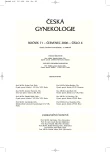Etiopathogenesis of the Prolapsed Vaginal Vault after Hysterectomy
Authors:
Milan Kudela; D. Ondrová; P. Hejtmánek
Authors‘ workplace:
Gynekologicko-porodnická klinika LF UP a FN Olomouc, přednosta prof. MUDr. M. Kudela, CSc.
Published in:
Ceska Gynekol 2006; 71(4): 329-332
Category:
Original Article
Overview
Objective:
To determine the main etiopathogenic factors which may participate in the development of vaginal prolapse after hysterectomy.
Design:
A retrospective study.
Setting:
Department of Obstetrics and Gynecology, Medical Faculty of the Palacký University and University Hospital, Olomouc.
Methods:
The analysis of relevant factors which can participate in the origin and development of vaginal prolapse was carried out on the group of 51 patients treated for vaginal prolapse after hysterectomy performed in the years 2002 to 2005. The data were retrieved retrospectively from medical documentation and appended by the information obtained from questionnaires send to the patients.
Results:
Factors participating in the development of vaginal prolapse can be divided into 3 groups: 1. Mistakes in surgical technique and complications in the post-operative period, 2. inherited qualities of patients, and 3. impact of adverse external factors.
Conclusions:
Several factors are involved in the etiopathogenesis of vaginal prolapse, the most important of which are the inherited qualities of patients, incorrect surgical technique and adverse outcome in the post-operative period.
Key words:
hysterectomy, vaginal prolapse, etiopathogenesis
Labels
Paediatric gynaecology Gynaecology and obstetrics Reproduction medicineArticle was published in
Czech Gynaecology

2006 Issue 4
Most read in this issue
- Etiopathogenesis of the Prolapsed Vaginal Vault after Hysterectomy
- Actual Management of Pregnancies at Risk for Fetal Anemia
- Harmatoma of the Breast – Case Report
- Gynecological Aspects of Thyroid Disorders. A Review
